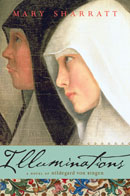By Mary Sharratt (W&M Contributor)

Born in the Rhineland in present day Germany, Hildegard of Bingen (1098–1179) was a visionary abbess and polymath, a Renaissance women before the Renaissance. She composed an entire corpus of sacred music and wrote nine books on subjects as diverse as theology, cosmology, botany, medicine, linguistics, and human sexuality, a prodigious intellectual outpouring that was unprecedented for a 12th-century woman. Her prophecies earned her the title Sybil of the Rhine.
2012 was Hildegard’s year. In May she was finally canonized, over eight centuries after her death, and in October she was elevated to Doctor of the Church, only the fourth woman in history to receive this rare distinction.
For twelve years I lived in Germanywhere Hildegard has long been enshrined as a cultural icon, admired by both secular and spiritual people. As a writer, I was struck by the pathos of her story. The youngest of ten children, Hildegard was offered to the Church at the age of eight. She reported having luminous visions since earliest childhood, so perhaps her parents didn’t know what else to do with her.
According to Guibert of Gembloux’s Vita Sanctae Hildegardis, she was bricked into an anchorage with her mentor, the fourteen-year-old Jutta von Sponheim, and possibly one other young girl. Guibert describes the anchorage in the bleakest terms, using words like “mausoleum” and “prison,” and writes how these girls died to the world to be buried with Christ. The anchorage was situated in Disibodenberg, a community of monks. What must it have been like to be among a tiny minority of young girls surrounded by adult men?
Hildegard spent thirty years interred in her prison, her release only coming with Jutta’s death. At the age of forty-two, she underwent a dramatic transformation, from a life of silence and submission to answering the divine call to speak and write about her visions she had kept secret all those years.
In the 12th century, it was a radical thing for a nun to set quill to paper and write about weighty theological matters. Her abbot panicked and had her examined for heresy. Yet miraculously this “poor weak figure of a woman,” as Hildegard called herself, triumphed against all odds to become the greatest voice of her age.
Hildegard’s life was so long and eventful, so filled with drama and conflict, tragedy and ecstasy, that it proved mightily difficult to squeeze into a manageable novel. I also felt quite intimidated to write about such a religious woman. In the end, I found I had to let Hildegard breathe and reveal herself as human.
Comment on this post to win a free copy of Illuminations: A Novel of Hildegard von Bingen
Mary Sharratt’s newest title, Illuminations: A Novel of Hildegard von Bingen, is published by Houghton Mifflin Harcourt and is a Kirkus Best Fiction of 2012 selection. Mary’s articles and essays have appeared in The Wall Street Journal, Huffington Post, Publisher’s Weekly, and on NPR.
